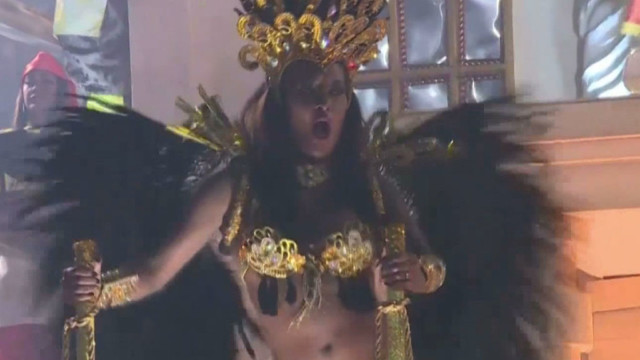The music-and-dance style known as “Samba”—invented by slaves—was once banned in Brazil. Now, it’s a fundamental part of the nation’s identity.
CGTN’s Lucrecia Franco has the story from Rio de Janeiro, as part of our “Black in Brazil” series.
Follow Lucrecia C. Franco on Twitter @LucreciaFranco
Rio de Janeiro’s Samba school parade is hailed as “the greatest show on earth”. It’s a unique competition of color and pageantry based one of the triumphs of African culture: the musical and dance form Samba.
This annual event was held at the Sambodrome stadium. Each Samba school parade represents one of the Rio’s poor neighborhoods, where most Afro-Brazilians live today.
Mangueira is one of the oldest Samba schools. Community supporters gather to sing and dance Samba at monthly fundraisers. And after generations, Samba has become a lifestyle.
“Samba is happiness, Samba is a protest, Samba is a statement. But above all, Samba is the love that unites everyone,” said Marcio Perrota, the Communications Vice President of Mangueira Samba School.
While historians agree about Samba’s essential roots, they differ on its exact origins and even the word—which is believed by some to come from an Angolan rhythm called “semba.”
“Samba is the combination of different African cultures,” explained Helena Theodoro, a professor of African Studies at the Rio de Janeiro Federal University. “It comes from the blacks from Angola, the blacks from Nigeria and with this intertwining you have the Samba Carioca.”
Cariocas, what Rio residents call themselves, claim Samba belongs to them, in part because the first recording of a Samba song happened here one hundred years ago. After decades of original compositions—made popular on the radio and television—almost every Carioca carries the music in their veins.
Samba is played throughout city streets, in cafes, bars, and parks. It is sung by young and old alike. It’s an amazing display, considering there was a time, at the turn of the 20th century, when it was banned.
Theodoro put it this way: “Basically Samba came from the poor suburbs of Rio. Why? Because it represented a way for the excluded black community to communicate their sorrows, their joy, and their need to get together.”
There are many Samba variations but one, quite possibly the original, known as “Root Samba,” is what musicians play in this part of Rio, known as “Little Africa”. It lies in the shadow of one of Rio’s most visibly iconic landmarks—Pedra do Sal, or “Salt Rock”—where historians say Samba was born.
On its steps, slaves unloaded salt and sang the songs that were the basis of this musical form. Today, it’s one of the best places to listen to Samba outside of Carnival.
A “roda de Samba”, or “Samba circle” set up around a table is a typical Samba formation. Djanir Pacheco, one of the musicians, said Pedra do Sal is sacred, “because it was the first place where a Samba circle happened, where everything began, where all they great Samba players performed.”
“And today,” he continued, “I am a professional that can support my family thanks to Samba.”
Over the centuries, Samba has created an essential cultural bond shared by whites, blacks and mulattos together. It is authentic Rio de Janeiro, said by many to have one of the world’s most unique cultural blends.
 CGTN America
CGTN America
